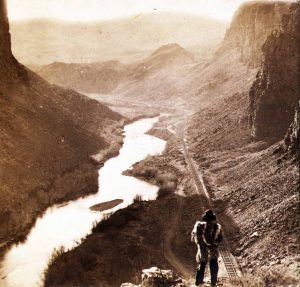We began this unit by discussing assumptions and differences that we carry into our class. In “First Contact as Spiritual Performance,” Lutz makes an assumption about his readers (Lutz, “First Contact” 32). He asks us to begin with the assumption that comprehending the performances of the Indigenous participants is “one of the most obvious difficulties.” He explains that this is so because “one must of necessity enter a world that is distant in time and alien in culture, attempting to perceive indigenous performance through their eyes as well as those of the Europeans.” Here, Lutz is assuming either that his readers belong to the European tradition, or he is assuming that it is more difficult for a European to understand Indigenous performances – than the other way around. What do you make of this reading? Am I being fair when I point to this assumption? If so, is Lutz being fair when he makes this assumption?
I do think that to some degree Lutz made an assumption on the profile of the reader, but a justified one at that, on the basis that we can conclude that this piece was primarily written for the academics foreign to the Indigenous worldview in the historical, cultural and spiritual sense. I believe this on the premise that Lutz himself is a history professor at the University of Victoria, and this piece has been (and is still) used as a scholarly discourse in Western post-secondary school circulations for quite a number of years. And “foreign” would have also included the European demographic who in this case, was a particular vital party in the European-Indigenous First Contact phenomenon.
When it comes to assumptions, I think that Lutz’s underlying message in “First Contact as Spiritual Performance: Encounters on the North American West Coast” is that the first encounters between Europeans and Indigenous people were full of them, and was perhaps not as innocent and open-minded as the term “First Contact” would lead some to believe. Lutz explains in First “Contact as Spiritual Performance: Encounters on the North American West Coast” and “Myths and Understandings: First Contact Over and Over Again” that both groups already possessed predisposed ideas of one another within their own cultural, and spiritual contexts even before initial interaction. To the Indigenous people, who saw “no firm divide between the natural world and the spirit world” (Lutz 35), the Europeans had a definitive place in their universe. Usually inserting them into old mythologies, “these strangers were usually seen as being something old – the dead returned, ancient people or spirits revisiting.” (Lutz 3). This active process of familiarizing strangers into native would undoubtedly cloud the Indigenous’s perspective in their first interactions. Further evidence of this would have been the names and rituals created by different tribes that would make sense of European encounters, such as the title of “Salmon People”, and the “White Man Dance” created by the Tahsis (Lutz 37). Europeans, who played the explorer role, would similarly go into first interactions with expectations of discovering myths they would find. And these expectations again, “…situated their contact encounters around mythological and historical frameworks imbued and colored by spiritual beliefs” (Luts 32). For example, Christopher Columbus’s first drawn maps who Lutz details to have had influence from sources such as “Orientalism” and Marco Polo’s book.
What that leaves us with is no true objective first contact between two communities of people alien from one another. Having read samples of both sides, it’s difficult to believe how each party was recounting the same events, which illustrates just how physical, tangible experiences are completely swallowed by an individuals cultural upbringing. So then, what we consider to be reality and experiences are really just “play-doh” that fit into our molds. Lutz here perfectly demonstrates the idea there is no true objectivity with social occurrence, the best we can do is collectively being objective.
I’d like to end this post off with a photograph that I found very powerful and relevant to our topic of conversation.

(Photograph by Alfred Hart)
This man standing is not one Indigenous to Canadian soil, nor is he looking over a Canadian railway. But I think the sentiment that this photograph portrays is similar to ones we’ve been reading and writing about in the Indigenous-Canadian First Contact occurrences. This photo was taken of a Native American between 1865-1869 looking over the Transcontinental Railway 435 miles from Sacramento, California. I think this photo perfectly encapsulates the concept of clashing stories and worlds. The Native American watches helplessly as his fabrics of his universe is being punctured by the ideals of another. One land, but different stories.
Works Cited
Lutz, John. “Contact Over and Over Again.” Myth and Memory: Rethinking Stories of Indignenous- European Contact. Ed. Lutz. Vancouver: U of British Columbia P, 2007. 1-15. Print.
Lutz, John. “First Contact as a Spiritual Performance: Aboriginal — Non-Aboriginal Encounters on the North American West Coast.” Myth and Memory: Rethinking Stories of Indigenous-European Contact. Ed. Lutz. Vancouver: U of British Columbia P, 2007. 30-45. Print.
An Introduction to Edward Said’s Orientalism- A Macat Sociology Analysis. Prod. Macat. Youtube. Youtube, 16 June 2015. Web. 16 Oct. 2016.
Christopher Columbus: What Really Happened. Prod. DavidandRemus Bad Crayfish. Youtube. Youtube, 6 Nov. 2013. Web. 16 Oct. 2016.